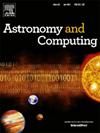Charge reconstruction of HERD silicon charge detectors based on MLP
IF 1.8
4区 物理与天体物理
Q2 ASTRONOMY & ASTROPHYSICS
引用次数: 0
Abstract
The High Energy Cosmic-Radiation Detection (HERD) is an experimental facility designed for the study of space astronomy and particle astrophysics. The Silicon Charge Detector (SCD), as the outermost detector of HERD, has the primary objective of precisely measuring cosmic rays ranging from hydrogen to nickel. To enhance the charge resolution of the silicon charge detector by fully utilizing multi-channel information, this study employed Support Vector Machines (SVM) and Multi-Layer Perceptron (MLP) for charge reconstruction. Given the challenge of low statistics in high- data, we also introduced transfer learning to improve charge reconstruction for high- samples. Compared to our previous results (Zhanget al., 2024), the machine learning algorithm achieved an average improvement of approximately 9.8% in charge resolution for heavy nuclei with = 10 to = 28.
基于MLP的HERD硅电荷探测器的电荷重构
高能宇宙辐射探测(HERD)是为研究空间天文学和粒子天体物理学而设计的实验设备。硅电荷探测器(SCD)作为HERD最外层的探测器,其主要目标是精确测量从氢到镍的宇宙射线。为了充分利用多通道信息,提高硅电荷探测器的电荷分辨率,本研究采用支持向量机(SVM)和多层感知器(MLP)进行电荷重构。考虑到高z数据的低统计量的挑战,我们还引入了迁移学习来改进高z样本的电荷重建。与我们之前的结果(Zhanget al., 2024)相比,机器学习算法在Z = 10到Z = 28的重核电荷分辨率上平均提高了约9.8%。
本文章由计算机程序翻译,如有差异,请以英文原文为准。
求助全文
约1分钟内获得全文
求助全文
来源期刊

Astronomy and Computing
ASTRONOMY & ASTROPHYSICSCOMPUTER SCIENCE,-COMPUTER SCIENCE, INTERDISCIPLINARY APPLICATIONS
CiteScore
4.10
自引率
8.00%
发文量
67
期刊介绍:
Astronomy and Computing is a peer-reviewed journal that focuses on the broad area between astronomy, computer science and information technology. The journal aims to publish the work of scientists and (software) engineers in all aspects of astronomical computing, including the collection, analysis, reduction, visualisation, preservation and dissemination of data, and the development of astronomical software and simulations. The journal covers applications for academic computer science techniques to astronomy, as well as novel applications of information technologies within astronomy.
 求助内容:
求助内容: 应助结果提醒方式:
应助结果提醒方式:


